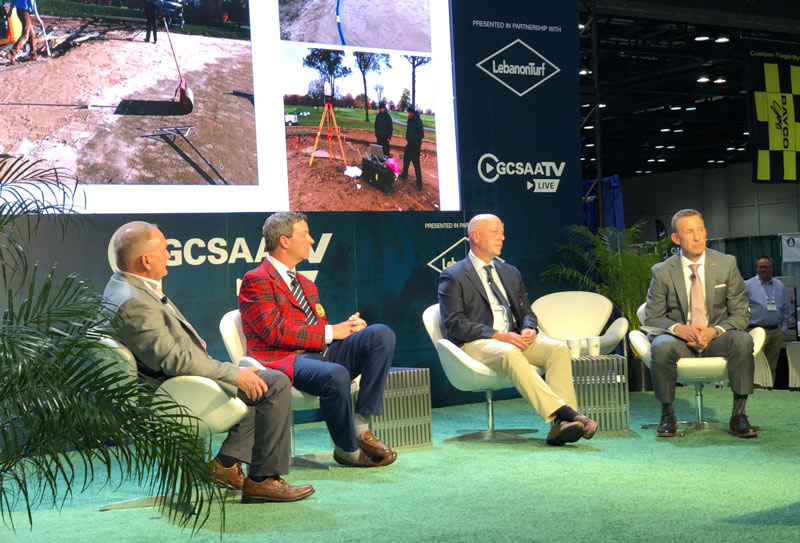
On hand to discuss the recent renovation work at Winged Foot Golf Club were (from left) Shellene Elmore, vice president of LaBar Golf Renovations; architect Gil Hanse; Stephen Rabideau, CGCS, director of golf courses at Winged Foot Golf Club; and GCSAA CEO Rhett Evans. Photo by Andrew Hartsock
The principals involved in the massive renovation project at Winged Foot Golf Club in Mamaroneck, N.Y., had no idea just how massive it would become.
What started as work on the practice facility eventually included a renovation on the East Course and, ultimately, morphed into a retooling of the West Course, all under the watchful eye of a demanding, informed membership and on a strict timeline leading up to the 2020 U.S. Open Championship.
“We gained the members’ trust,” architect Gil Hanse said during the Wednesday session “It Takes a Team: Collaboration and Insight Into Preparing and Completing the Renovation at Winged Foot Golf Club,” part of activities at the 2020 Golf Industry Show at the Orange County Convention Center in Orlando, Fla. “We got to the point we would never had dreamed of, where we had access to the whole West Course.”
The West will host the U.S. Open in June.
After work on the short game area had been completed, renovation work shifted to the East Course.
“Both courses have always been in the Top 100. The East Course was in danger of falling out of the Top 100. I think it was down to 97. It needed a little TLC,” said Stephen Rabideau, CGCS, director of golf courses at Winged Foot and a 26-year GCSAA member.
The primary players were well aware of the weight of the project. The 1923 A.W. Tillinghast design has hosted, among other big-name events, five previous U.S. Opens.
So, how’d they do it?
“All three of us knew our roles,” Rabideau said of crews headed by himself, Hanse and Shellene Elmore, vice president of LaBar Golf Renovations. “We all trusted each other and did what we had to do.”
Each of the three had a different key takeaway:
• “The biggest thing I learned,” Elmore said, “was in the first phase, on the East Course, I overthought everything. The biggest thing I learned was to keep it simple.”
• Rabideau wished he had known it was to be a full 36-hole project when it started, especially given the crunch of growing all of his own sod: “We had sod nurseries throughout our property. ... I wish I had started earlier.”
• “I learned never to question a golf course superintendent when it comes to turf,” Hanse said with a laugh.
And what was the final price tag?
“Uh, more than a little,” Rabideau said after a pause from the question from the audience. “C’mon, you don’t ask that question.”
Andrew Hartsock is GCM’s managing editor.